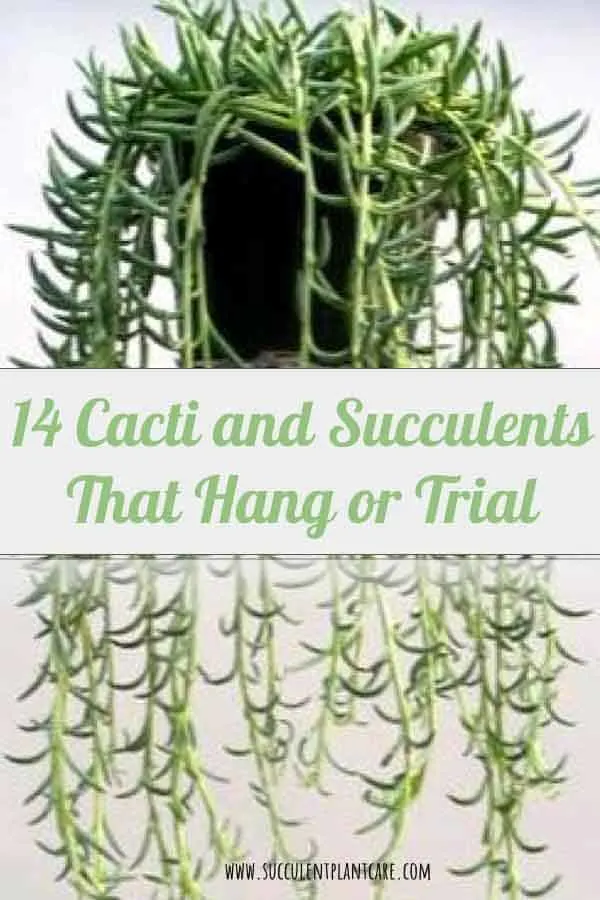Succulents that hang or trail seem to be growing more and more in popularity.
They can be found anywhere from hanging baskets, fairy garden teapots, living wreaths and wall art, to anywhere in between.
I for one love these hanging succulents and cannot seem to get enough of them. They look great almost anywhere you stick them in, and they add plenty of charm and character in any arrangement.

Top Hanging or Trailing Succulents:
- Senecio Rowleyanus (String of Pearls, String of Peas)
- Senecio Herreianus (String of Beads)
- Senecio Radicans (String of Bananas)
- Fish Hook Senecio or Grey Fishhooks Senecio
- Dischidia Nummularia (String of Nickels)
- Crassula Pellucida Variegata (Calico Kitten)
- Ceropegia Linearis Woodii (String of Hearts, Rosary Vine)
- Hoya (The Hindu Rope, Wax Plant)
- Sedum Burrito (Burro’s Tail, Baby Donkey Tail)
- Sedum Morganianum (Donkey’s Tail, Burro’s Tail, Lamb’s Tail)
- Othonna Capensis (Little Pickles, Ruby Necklace)
- Aporocactus Flagelliformis (Rat Tail Cactus)
- Echinopsis Chamaecereus (Peanut Cactus)
- Hildewintera Colademononis (Monkey’s Tail)
Here are some popular succulents and cacti that hang or trail:
Senecio Rowleyanus (String of Pearls, String of Peas)
Native to South Africa, these plants have become coveted for their beauty and versatility.They look good pretty much anywhere you stick them in and they add another dimension to your arrangement. From hanging baskets to little teacups, they can definitely grab people’s attention.
The stems can grow up to 3ft (90cm) long and can be left hanging or trailing. When cut, the stems will split into two or more and keep on growing. The stems are lined with small, round, pea-like green leaves. These plants are not frost tolerant.
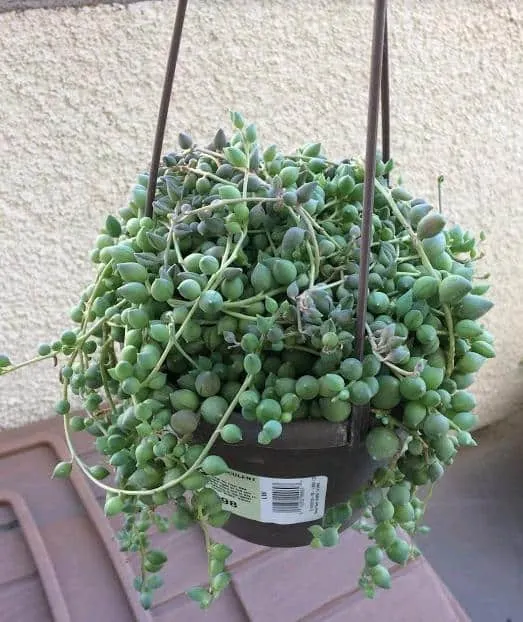
Caring for String of Pearls can be easy once you figure these guys out. Like other succulent plants, they need a well draining soil. Established plants need less water than younger plants. Water only when the soil is dry, but do not let the soil dry out completely.
They need bright but indirect sunlight and need to be protected from intense afternoon sun. They do well in a partially shaded area, or in planters shaded by other taller plants. They produce these fuzzy white flowers that have a sweet, vanilla scent.
Senecio Herreianus (String of Beads)
These are very similar to the more common Senecio Rowleyanus (String of Pearls). The difference is in the shape of the green leaves. These have a more pointed and oval shaped leaves, rather than round ones.
The stems can grow up to 3ft (90cm) long. Cut stems can be propagated and root fairly easily. The cut part splits and will keep on growing.
These plants look great in hanging baskets but can also be planted in-ground as ground cover. When planted in-ground, they creep and drape the soil. They need to be protected from frost.
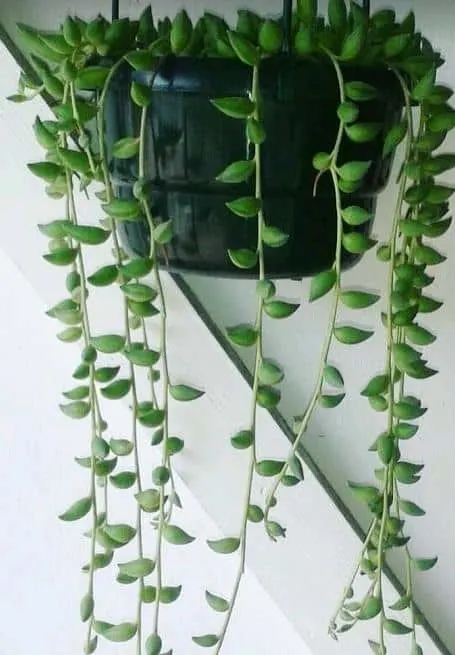
Established plants are drought tolerant. They need a well draining soil. Water when the soil is dry. Place in a partially shaded area, away from intense afternoon sun. They produce white fuzzy flowers that smell like vanilla.
Senecio Radicans (String of Bananas)
Native to South Africa, these are fast growing plants with stems that can reach 3ft (90cm) long. They have green leaves that are shaped like mini green bananas. They produce little white, yellow or lavender fuzzy flowers similar to String of Pearls that have a sweet cinnamon scent.
Stems can be cut and propagated. Cut stems split into two or more and continue to grow. These are hardy plants that can be grown as vines or cascading down a tall planter or a hanging planter..
I find these plants easier and hardier than the String of Pearls plant. Water when the soil is dry. Provide a well draining soil and protect from extreme afternoon sun and frost.
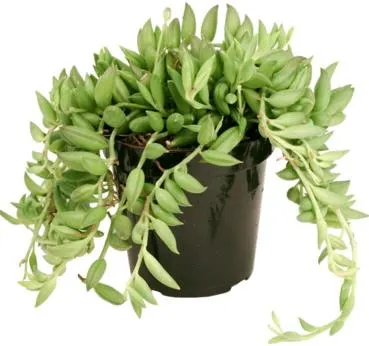
Fish Hook Senecio or Grey Fishhooks Senecio
These are very similar to String of Bananas and they are sometimes referred to by the same names, which can add to the confusion. The only real marked difference is in their leaves. These have flatter, longer leaves than String of Bananas.
The leaves are bluish green in color and are shaped like fish hooks. Native to South Africa, these are great for hanging baskets or even in ground as vines.
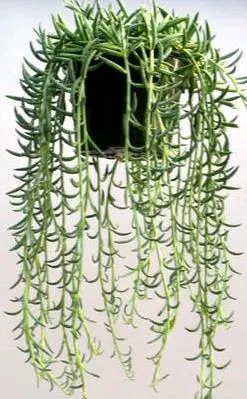
They need a well draining soil. Water when the top inch of the soil is dry. Provide bright light but protect from intense afternoon sun. They also need protection from frost.
Dischidia Nummularia (String of Nickels)
The String of Nickels have green, bluish gray leaves that are flat and round, giving them the appearance of coins (nickels) hanging on a string. Their native habitat is in the tropical rainforest and they are epiphytes by nature.
Epiphytes are plants that grow on other plants, tree trunks or rocks. They look great in hanging baskets, wall art, living wreaths, or cascading down the sides of a planter. They produce creamy white flowers.
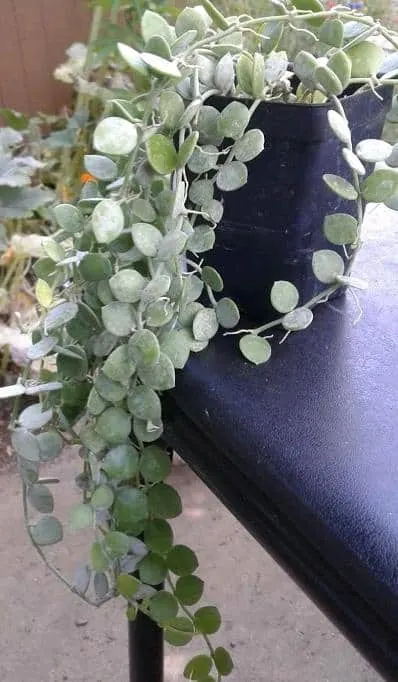
Since they are epiphytes by nature, they need a well draining soil, preferably one for designed for epiphytic plants containing shredded bark or coconut husks. You may also add gravel, coarse perlite or pumice to a cactus soil mix to improve drainage.
These require more humidity than other drought tolerant succulents. Bright indirect light works best for them.
Crassula Pellucida Variegata (Calico Kitten)
Crassula Pellucida Variegata (Calico Kitten) is a beautiful plant with colorful and heart-shaped variegated leaves. The leaves are a combination of different shades of green, pink, purple and cream. I just adore this plant.
It has become one of my favorites. The plant trails and look great in a hanging baskets. They are also effective as ground cover.
They turn a dark purple when exposed to full sun. They produce white flowers. These need a well-draining soil. Water when the soil is dry.
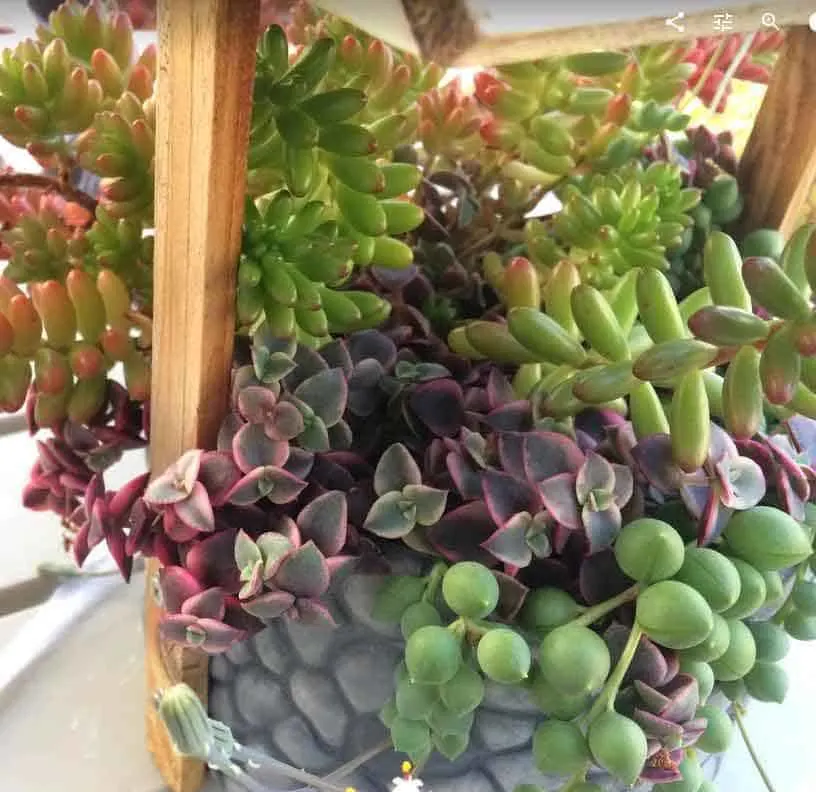
Ceropegia Linearis Woodii (String of Hearts, Rosary Vine)
These are succulent vines with heart shaped leaves. Native to South Africa, their vines can trail endlessly and can reach over 6ft (183cm) long. Their leaves are pale to dark green in color. String of Hearts are related to the Hoya and share the same family. They look great in hanging baskets a few feet up, or trailing as vines in a container.
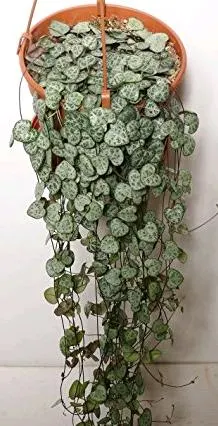
String of Hearts are easy to care for. Provide bright but indirect light. Water when the top inch of the soil is dry. Water more in the warmer summer months and less during winter. Provide a well draining soil.
Hoya (The Hindu Rope, Wax Plant)
Native to Southern India, East Asia and Australia, hoya plants are known for their thick, almost heart-shaped leaves and vine-like qualities. Hoyas are also known as the Hindu Rope or Wax Plant. Not all hoya species are succulents, but some are.
Hoyas are very popular houseplants and do well indoors or out. They need bright but filtered light and need to be protected from intense afternoon sun. Most do well in partial shade. They are typically grown in hanging baskets.
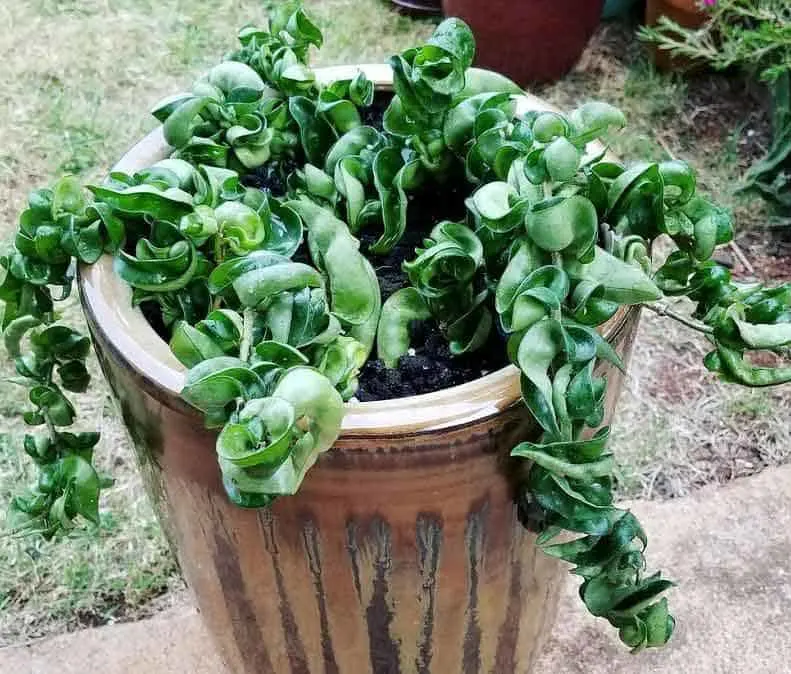
Hoyas need a little more moisture than other succulents. Provide a well draining soil and water when dry. Water more during the growing season and less during winter.
Sedum Burrito (Burro’s Tail, Baby Donkey Tail)
Native to Southern Mexico, Sedum Burrito is known for their long, hanging stems covered with dense, plump, lime-green to blue-green leaves. The stems can hang and grow up to 12in (30cm) in length, or longer. They are related to Sedum Morganianum, but the leaves are smaller and shorter.
These plants are very popular plants to use in hanging baskets, or spilling down the side of a tall planter, or trailing out of a wall display. Their unusual appearance are definitely eye-catching. They produce flowers that are fragrant and sweet-smelling.

Once established, these plants are easy to grow. Provide a well draining soil. Water only when the top inch of the soil is dry. Water less during the winter months and more during warmer summer months. Provide bright but indirect light.
Sedum Morganianum (Donkey’s Tail, Burro’s Tail, Lamb’s Tail)
Native to Southern Mexico, these are very similar to Sedum Burrito. The difference is in the shape of the leaves. These have longer and flatter lime-green to blue-green leaves that are pointy. Like Sedum Burrito, these plants are very popular plants to use in hanging baskets or used as trailing plants in different arrangements.
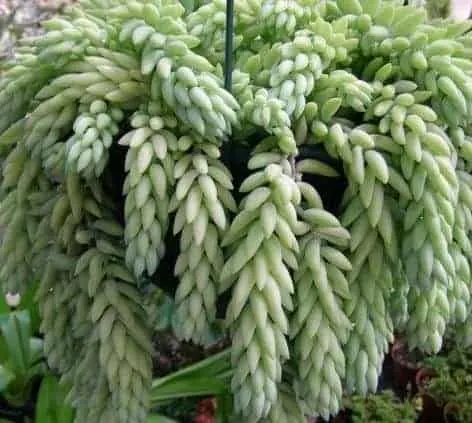
Once established, they are very drought resistant. They need a well draining soil. Water only when the top inch of the soil is dry. Give the plant a good drink and then wait for the soil to dry before watering again. They do best with bright but indirect sunlight.
Othonna Capensis (Little Pickles, Ruby Necklace)
Native to South Africa, this trailing succulent make an attractive hanging plant because of its vibrant colors. They have plump, bean-shaped, blue-green leaves and bright, reddish-purple stems. They produce bright yellow daisy-like flowers.
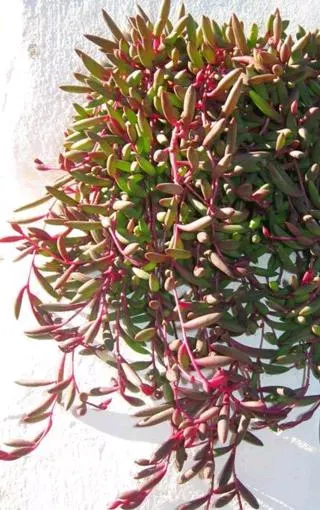
They prefer bright sunlight and will tolerate full sun. Plant in a well draining potting mix. Water when the soil is dry. Provide more water during the summer heat and less during winter months.
Aporocactus Flagelliformis (Rat Tail Cactus)
Native to Mexico, these can be grown indoors and outdoors. Rat Tail cactus have long stems that trail and wind, and can grow up to 3 ft (1m) long. The stems have tiny, fine spines that almost appear fuzzy. Flowers are beautiful, bright pink or red in color.
These are best grown in hanging baskets or in a tall pot with room for the tall stems to spread and grow out.
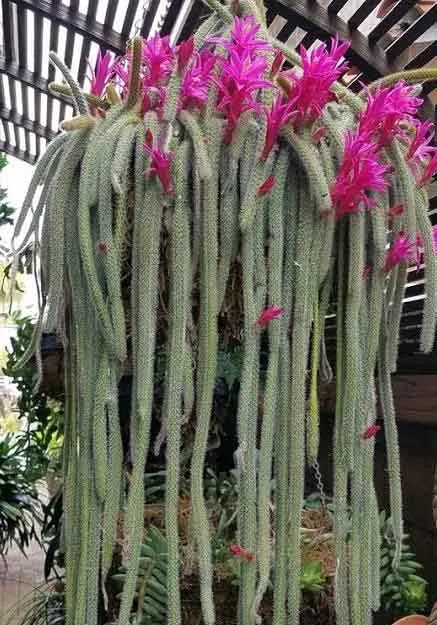
These are easy to grow from stem cuttings. They require bright light and a well draining cactus soil. Water when the soil is dry. Water more during warmer summer months and keep dry during winter.
Echinopsis Chamaecereus (Peanut Cactus)
Native to Argentina, these cacti grow in clumps of finger-like stems, reaching about 6 in (10 cm) in length. The stems are covered with small white spines that are soft and bristly. They produce large bright orange-red flowers. These cacti do well in hanging baskets with their stems branching freely.
Provide a well draining potting mix. Water when the top inch of the soil is dry. Water more during hot summer months and keep dry during winter months.
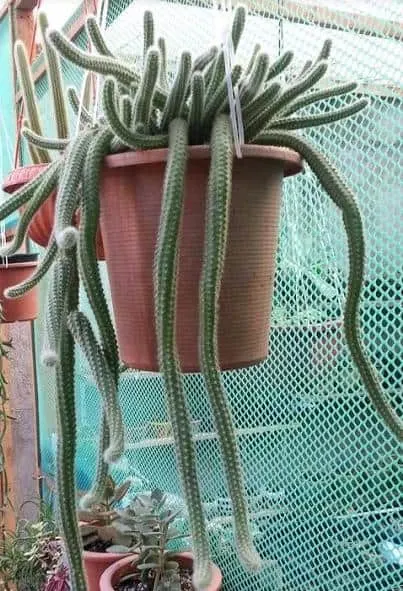
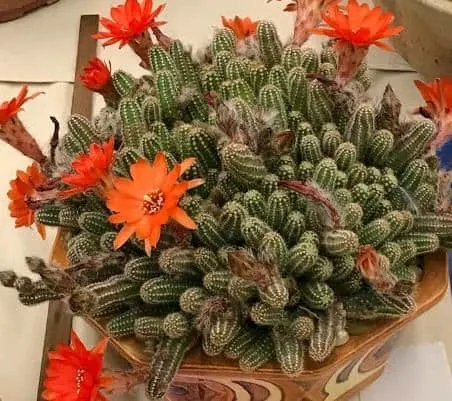
Hildewintera Colademononis (Monkey’s Tail)
Also known as Cleistocactus Winterocereus, these cacti are native to Bolivia. They grow upright at first, then trail as they mature. They can grow up to 8ft (2.5m) long. The stems are light green in color and completely covered with long, soft, white hairy spines.
These cacti are epilithic in nature, meaning they grow on rocks. They clump at the base and branch out as they grow. They produce bright red or magenta colored flowers.
They need a well-draining soil and a bright location. They can tolerate full sun. Water more during warmer months and keep dry in winter.
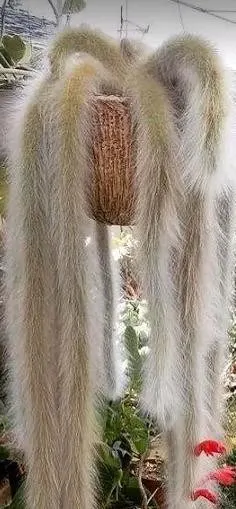
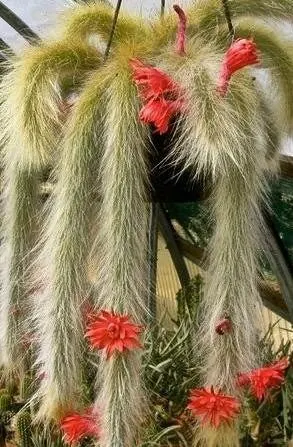
If you are wondering where you can purchase succulents online, please check out my Resource Page to get some ideas.
Are succulents good hanging plants?
I enjoy looking at hanging or trailing plants. Hanging plants are such a joy to cultivate and grow as they enhance the garden feel of your private garden. The question is are succulents good hanging plants?
Many succulents are good hanging plants but many don’t hang nor trail. String of Pearls, String of Banana, String of Dolphins, Variegated Portulacaria Afra, and some Sedums species are good hanging succulent plants.
How do you care for a hanging succulent?
Taking care of hanging succulents isn’t too difficult, there are a few important tips you should know about taking care of hanging succulents to make sure they don’t die on your watch.
As a general rule, hanging succulents have thinner branches. If you left them under extreme sunlight they could easily dry out. Also, you don’t need too much soil for hanging succulents most of them have thin roots so use appropriate pot sizes. And finally, water when the soil feels dry they die mostly from overwatering.
What succulents are best for hanging baskets?
There are many succulents that could work well in hanging baskets. But not all succulents are suitable for hanging baskets. Succulents with thin stems that don’t stand upright are good candidates for hanging baskets.
Succulents best for hanging baskets are string of pearls, string of dolphin, string of banana, variegated portulacaria afra and string of buttons are some of the best succulents for hanging baskets.
Where do you hang hanging succulents?
Most species of succulents that hang are the ones that are not very fond of direct sunlight. This means you need to be careful where you hanging your succulents to avoid killing them.
As a rule of thumb, hang your hanging succulents by a bright window without direct hot sun light. If you live in a place where your morning sun is warm but not hot, east facing window should work just fine. However, if you live at a location where the sun can be extremely hot, you might need to hang them by window that don’t get direct sun light.
